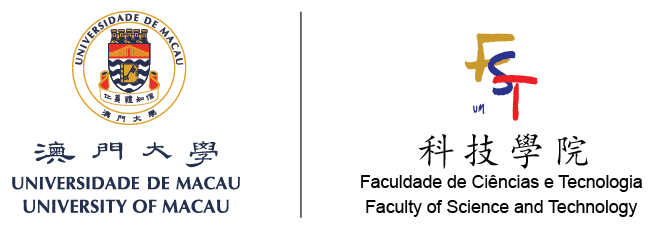UM’s FST Summer Camp broadens secondary school students’ research horizons
澳大科技夏令營開拓中學生科研視野
The Faculty of Science and Technology (FST) of the University of Macau (UM) recently held the FST Summer Camp. It featured nine technology-related themes and attracted 240 students from 30 secondary schools in Macao. The summer camp was rich in content and enabled local secondary school students to learn about advanced research fields and broaden their horizons through a combination of lectures and hands-on experiences.
The summer camp covered various topics such as new environmental materials, mechatronics engineering, robotics, artificial intelligence, marine science and technology, smart city, internet of things, climate change, civil engineering, numerical computation, integrated circuit design, and autonomous driving. The students participated in activities on different themes according to their interests. Led by professors and postgraduate students from the faculty, the students visited several laboratories at UM as well as private enterprises outside the campus. They also gained a better understanding of research at the university by attending lectures and having access to state-of-the-art research equipment. In addition, the students also visited the UM campus, residential colleges, exhibition halls, and the library to learn more about the university’s history, academic achievements, and teaching and research development, and experienced its international education setup and academic atmosphere.
In particular, 40 students who joined the integrated circuit design summer camp visited the State Key Laboratory of Analog and Mixed-Signal VLSI of UM. They took part in the chip design process, attended lectures, and engaged in experiment sessions to measure electronic circuits, so as to familiarise themselves with integrated circuit design and the relevant research. The students also interacted with UM professors and researchers to acquire professional knowledge.
The FST has been dedicated to promoting innovation and education in science and technology in Macao over the years. The summer camp provided local secondary school students with learning opportunities and a platform for exchange and communication. It aimed to foster their interest and potential in science and technology, stimulate their innovative thinking, and enhance their organisational and teamwork skills, thus promoting the cultivation of technological professionals and the development of research in Macao.
澳門大學科技學院舉辦九個不同主題的科技夏令營,吸引澳門30間學校共240名中學生參與。一系列夏令營內容充實,結合課堂與實踐,推動中學生了解先進科研領域和開拓視野。
夏令營涵蓋新型環保材料、機電工程、機器人、人工智能、海洋科學及技術、智慧城市、物聯網、氣候轉變、土木工程、數值計算、晶片設計及智能駕駛等主題,學員按興趣參與不同主題的活動。在學院教授及研究生帶領下,學員參觀了澳大多個實驗室和校外企業,同時透過專題演講和接觸先進科研儀器,加深認識澳大研究。此外,學員參觀了澳大校園、住宿式書院、展館及圖書館,了解澳大的歷史沿革、學術成就及科教發展,感受國際化的教育和學術氛圍。
其中,40名參加晶片設計夏令營的學員參觀了澳大模擬與混合信號超大規模集成電路國家重點實驗室並體驗晶片設計流程、參加講座和開展電路測試實驗等,以了解晶片的設計及研究工作;同時,學員還與澳大教授和研究人員進行互動交流,學習專業知識。
澳大科技學院一直致力推動澳門科技的創新和教育,是次夏令營為中學生提供了寶貴的學習機會和交流平台,啟發他們對科技的興趣與潛能、激發創新思維、提升組織及團隊協作能力,從而推動科技專才的培養及澳門科研的發展。
UM students win a best paper award at International Symposium on Thermal-Fluid Engineering 澳大學生奪國際研討會最佳論文獎
UM students win a best paper award at International Symposium on Thermal-Fluid Engineering
Mr. Jiahang Chen, a doctoral student, and Ms. Kaiwen Wu, a master student, from the Department of Electromechanical Engineering (EME), Faculty of Science and Technology (FST), University of Macau (UM), has won the best paper award at the 4th International Symposium on Thermal-Fluid Dynamics (ISTFD 2023), which was hosted by Nanjing University of Aeronautics and Astronautics (NUAA).
ISTFD is one of the leading annual international forums on Thermal-Fluid Dynamics, which aims to advance scientific knowledge and technology development of Thermal-Fluid Dynamics and relevant emerging, cutting-edge and interdisciplinary subjects. The symposium attracted a total of 156 papers from different universities and state key laboratories from all over the world.
In the symposium, Ms. Kaiwen Wu represented the research group to present a paper titled “Experimental Investigation of Pressure Drop and Heat Transfer Characteristics for Horizontal Flow Using Traditional and 3D-Printed Mini Tubes”. The research project was supervised by Prof. Lam Mou Tam, Professor of Department of EME, and was jointly sponsored by the Science and Technology Development Fund of Macau, the National Natural Science Foundation of China, and the Institute for the Development and Quality, Macau. As an advanced manufacturing technology, Selective Laser Melting (SLM) 3D printing technique, which was one of the additive manufacturing methods, could be used to print sophisticated and small-sized heat exchangers with large heat transfer areas so it has attracted high attention in the thermal engineering community in recent years. Due to the difference in the metal surface characteristics between 3D-printed tubes and traditional tubes, the research team experimentally compared the pressure drop and heat transfer characteristics inside a 3D-printed stainless-steel tube and a traditional cold-rolled stainless-steel tube under isothermal and non-isothermal boundary conditions. The results showed that the friction factors and heat transfer of the 3D-printed tube were different from the traditional cold rolled tube in terms of data trend and magnitude, especially in the upper transition and turbulent regions. Therefore, the new correlations in the upper transition and turbulent regions were developed to predict the friction factors and heat transfer coefficients of the 3D-printed tube for the application in the thermal systems. The efforts and achievements of the research team were fully recognized by experts at the symposium.
澳大學生奪國際研討會最佳論文獎
澳門大學科技學院機電工程系博士生陳佳航和碩士生吳凱雯於南京航空航天大學主辦的第四屆熱與流體動力學國際研討會 (ISTFD 2023)奪得最佳論文獎。
熱與流體動力學國際研討會為熱與流體力學領域主要的國際研討會之一,致力於推動熱與流體力學及相關新興、前沿和跨學科的知識和技術發展。是次研討會吸引了來自世界各地不同大學及國家重點實驗室的投稿,最終僅接收156篇論文。
在研討會上,吳凱雯同學代表研究團隊報告了論文題為《傳統及3D打印水平微管內的壓降和傳熱特性之實驗研究》。此研究課題是由機電工程系教授譚立武指導,並由澳門科學技術發展基金、國家自然科學基金及澳門發展與質量研究所共同贊助。增材製造作為一種先進的製造技術,如選擇性雷射熔化(SLM)的3D打印技術,能打印出體積小但傳熱面積大的特殊熱交換器,因此近年引起了熱力工程界高度關注。由於打印的管道和傳統管道在金屬表面特徵上存在差異,因此,研究團隊在等溫和非等溫的邊界條件下,利用實驗方法比較SLM技術的3D打印不銹鋼管和傳統冷軋不銹鋼管壓降和傳熱特性。實驗結果顯示3D打印鋼管與傳統冷軋鋼管摩擦因子與熱傳系數的數據趨勢與幅度是不同的,在湍流時分別更大。因此,研究團隊針對3D打印管道開發了在過渡流及湍流區域上的摩擦因子與熱傳系數的新關聯式,供熱能系統使用。研究團隊的努力和成果獲得專家們的充分肯定。









